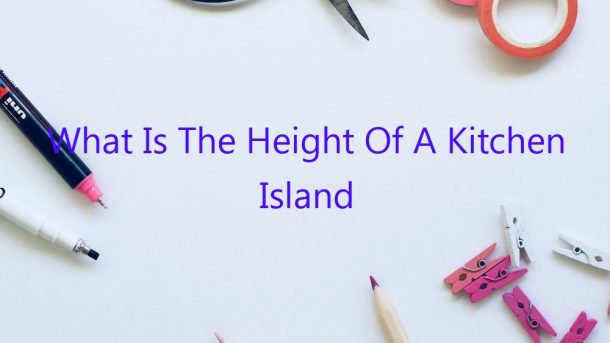What Is The Height Of A Kitchen Island?
A kitchen island is a great way to add extra counter and storage space to your kitchen. They come in all shapes and sizes, and you can find one that fits your needs and your kitchen’s layout. One thing to consider when choosing a kitchen island is the height.
The height of a kitchen island can vary, but it’s typically around 36 inches high. This is a comfortable height for most people, and it’s high enough to provide extra work space but low enough to not be a nuisance. If you’re looking for a kitchen island that’s a little taller, there are options available that are around 42 or 44 inches high.
Keep in mind that the height of your kitchen island can also affect the look and feel of your kitchen. A taller island might make the space feel a little more cramped, while a shorter island might make the room feel more open. It’s important to choose an island that fits the layout and vibe of your kitchen.
If you’re still unsure about what height is right for you, talk to a kitchen designer. They can help you find an island that fits your needs and your kitchen’s layout.
Contents [hide]
Should a kitchen island be the same height as counter?
When it comes to designing your dream kitchen, there are a few decisions to make. One of those decisions is whether or not to have a kitchen island. If you do choose to have a kitchen island, there is another decision to make – should the island be the same height as the countertops?
There are pros and cons to both options. If you choose to have the island be the same height as the countertops, it can make the kitchen feel more open and cohesive. It can also be more convenient, as you won’t have to reach up or down to get to the countertops.
However, if you choose to have the island be a different height than the countertops, it can add visual interest to the kitchen. It can also be more functional, as you can use the island as a workspace or place to sit.
Ultimately, the decision of whether or not to have the island be the same height as the countertops is up to you. Consider both options and decide which one would be best for your kitchen.
Are kitchen islands counter height or bar height?
Are kitchen islands counter height or bar height? This is a question that many homeowners have when they are considering adding an island to their kitchen. The answer to this question depends on your needs and what you plan to use your island for.
Kitchen islands are a great addition to any kitchen. They provide extra counter space and can be used for storage, seating, or as a prep area. When deciding if your island should be counter height or bar height, you need to consider what you will use it for.
Counter height islands are perfect for food preparation and general use. If you plan to use your island as a work surface, then a counter height island is a good option. They are also a good choice if you want to add extra seating to your kitchen. Counter height islands typically range in height from 34 to 36 inches.
Bar height islands are ideal for use as a bar or breakfast bar. They are also a good choice for use as a prep area for baking or for using a stand mixer. Bar height islands typically range in height from 40 to 42 inches.
If you are not sure which height is right for you, it is best to consult with a kitchen designer to help you decide. They will be able to help you determine what your needs are and what will work best in your kitchen.
What is a typical size for a kitchen island?
A kitchen island is a great way to add extra counter and storage space to your kitchen. But what is a typical size for a kitchen island?
According to the National Kitchen and Bath Association, the average kitchen island size is 9 feet by 3 feet. But your kitchen island can be any size that works for your needs.
If you’re looking for extra counter space, a larger island may be the right option for you. But if you’re looking for extra storage space, a smaller island may be a better fit.
No matter what size island you choose, be sure to factor in the space you’ll need for appliances, cabinets, and storage. And be sure to consult with a professional before installing your kitchen island to ensure it’s the right size and shape for your kitchen.
What is counter height for an island?
What is the ideal counter height for an island? This is a question that many homeowners have when designing their kitchen. There is no one perfect answer to this question, as it depends on your personal preferences and the layout of your kitchen. However, there are some things to consider when deciding on the right counter height for your island.
One of the most important factors to consider when choosing a counter height is how you will use the island. If you plan to use the island as a regular work surface, you will want to choose a height that is comfortable for you to work at. If you plan to use the island as a dining table or as a place to gather with friends and family, you will want to choose a height that is comfortable for sitting at.
Another thing to consider is the height of your cabinets and appliances. If your cabinets and appliances are low, you will want to choose a counter height that is lower than average. If your cabinets and appliances are high, you will want to choose a counter height that is higher than average.
The standard counter height in the United States is 36 inches, but you may want to choose a height that is different depending on your personal preferences and the layout of your kitchen.
Can kitchen island be lower than counter?
Countertops and kitchen islands are typically the same height, but can a kitchen island be lower than the countertops? The answer is yes, a kitchen island can be lower than the countertops, but there are a few things to consider before doing so.
One reason you might want to have your kitchen island lower than the countertops is if you have young children. Having the kitchen island lower makes it easier for them to reach and helps prevent them from standing on a chair to reach the countertops.
Another reason you might want to have your kitchen island lower is if you have a disability that affects your ability to stand or walk. Having the kitchen island lower can make it easier for you to do tasks in the kitchen.
There are a few things to consider before lowering your kitchen island. First, make sure that the cabinets and appliances on the island are all at a height that is comfortable for you to use. If the cabinets and appliances are too high or too low, it can be difficult to use them.
Another thing to consider is the type of countertop you have. If you have a granite or stone countertop, it is important to make sure that the island is the same height or higher than the countertop, as these countertops are very hard to cut. If you have a wooden countertop, you can have the island lower than the countertop.
Before lowering your kitchen island, it is also important to consult with a contractor to make sure that it can be done safely. If your kitchen island is lowered too much, it can cause problems with the structural integrity of your kitchen.
Overall, if you have young children or a disability that affects your ability to stand or walk, it is worth considering having your kitchen island lower than the countertops. Just make sure to consult with a contractor before doing so to make sure that it is safe and feasible.
How long should an island be for 3 stools?
When it comes to kitchen islands, there are a few things to consider when deciding on the size. How many people will be using the island? What type of activities will take place on the island? And, of course, how much space is available in the kitchen?
For a kitchen island with three stools, a good size is around 4-6 feet long and 2-4 feet wide. This will provide ample space for cooking, prepping, and dining. If the island is too small, it may not be functional for all of your needs. If it is too large, it may feel overwhelming and take up too much space in the kitchen.
Can you put an island in a 12×12 kitchen?
Can you put an island in a 12×12 kitchen?
The answer to this question is yes, you can put an island in a 12×12 kitchen. However, there are some things you should keep in mind when deciding whether or not an island is the right fit for your kitchen.
First, consider the size of your kitchen. If it’s small, an island may be too large and take up too much space. In a small kitchen, it’s important to choose furniture and appliances that are both functional and space-efficient.
Second, think about what you’ll use the island for. If you plan to use it for cooking or food preparation, make sure it has enough counter space and storage. If you’ll be using it for dining or as a work space, make sure it has a comfortable seating area.
Finally, consider your budget. An island can be a costly addition to your kitchen, so make sure you have the funds to cover the cost.
If you can answer these questions and still feel like an island would be a good fit for your kitchen, go ahead and add one! They provide a lot of extra counter and storage space, and can be a great place to eat or work.




